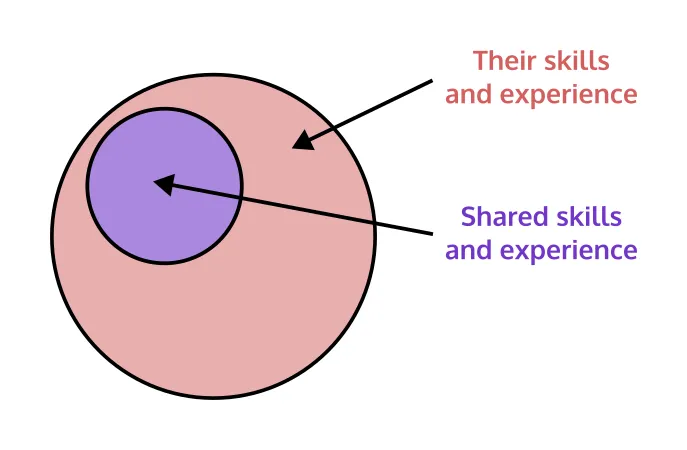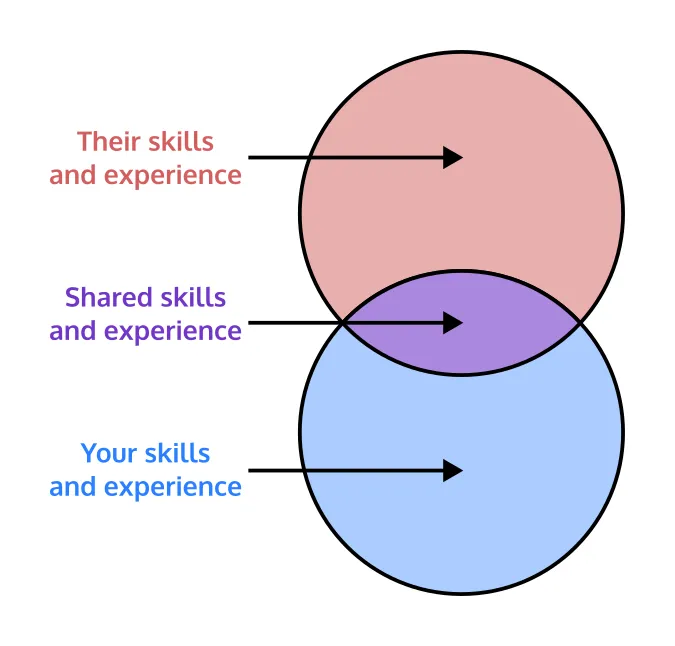Resources
The cure for impostor syndrome
One little diagram might be all you need. Includes a free poster!

Quinn Daley they/them
Technical leadership consultant

Impostor syndrome is the feeling that you don’t quite belong or deserve to be in the role or position or meeting that you’re in. That everyone else seems somehow better or more knowledgable or more skilled than you.
Have you experienced impostor syndrome? You’re not alone - I have encountered it in every coaching situation I’ve ever been in, and experienced it myself on many occasions.
The good news is, there’s a cure! Or, at the very least, I’ve found that this one small diagram has helped numerous people to reframe their thinking around impostor syndrome.
Read on for the explanation, and then I have a free poster for you at the end to print and stick on your wall!
How impostor syndrome feels
When you experience impostor syndrome, it feels like your knowledge, skills and experience are a subset of the knowledge, skills and experience of your colleagues in similar roles.
If you were to draw these as two circles, you might imagine your colleagues having a much larger circle, with your circle being much smaller and squashed inside. Something like this:

What it really is
What if I told you the reason it feels that way is because you’re only looking at the things you have in common?
Every member of a team brings unique skills, knowledge and experience to the table, and that’s part of why teams hire multiple people. This is especially true in senior and leadership roles.
It’s normal for your colleagues to know things, to be able to do things and to have experience of things that don’t align with your own skills and experience. But the same is true of you! There’s loads that you know and that you bring to the table that your colleagues don’t know and can’t do!
In fact, the smaller circle in the first diagram does exist, but it is not a circle. It’s the intersection of two circles of similar size.

Thinking of your impostor syndrome this way can help you to celebrate the differences between you and your colleagues. Yes, they know things you don’t know. Yes, they can do things you can’t do. But the same is true of you with them!
An example
As teams get more diverse and inclusive, impostor syndrome will be on the up too. Diversity of thought decreases the overlap between the circles in the second diagram, and this is always a good thing because the overall knowledge and expertise in the team is greater.
When I was leading software engineers, I had team members who had great theoretical knowledge of computer science, likely from studying it to degree level at university. I also had team members who had learnt software engineering through a bootcamp and “on the job”, as a consequence of a career change. Some people in the second group experienced extreme impostor syndrome when sharing meetings or discussions with the first group: the missing knowledge felt like a prerequisite for the role.
In that situation, I used this diagram to demonstrate that many of the skills they had acquired as a consequence of having a whole earlier career, such as a strong aptitude for numbers or the ability to see a problem from multiple stakeholder perspectives, were just as valuable to the team, and that the team wouldn’t have been able to accomplish the things it did without those skills.
Knowing that both they and their colleagues had skills the other didn’t, helped them to understand there’s no shame in having something to learn: both groups of people could learn from each other and no one set of skills was more valuable than the other.
Free poster!
I hope seeing the reality of impostor syndrome laid out as a pair of diagrams has helped you the way it has helped me and others that I’ve worked with.
I’ve put this diagram together as a printable poster that you can put on your wall as a constant visual reminder. There’s even a little QR code to take you back to this blog post any time you like!
Download posterIf you use this poster, I’d love to see pictures of it on your wall!
Credit where credit’s due?
I have shared this diagram with people over and over, but I wasn’t the first person to draw it - or at least something like it. It’s so simple that I’ve been able to draw it again each time, meaning I’ve long forgotten where I found it originally.
If you know the originator of the concept of this diagram, I’d love to credit them here. Please get in touch to let me know!
Please share this post!
Do you know someone else who is experiencing or has previously experienced impostor syndrome? Maybe a friend or one of your line reports?
Please share this blog post and the poster with anyone who would benefit from seeing it!
Calling it the “cure” was probably a bit of an exaggeration, but I’ve found it has helped many people when I’ve shown it to them.
Fish Percolator is a technical leadership consultancy based in Yorkshire.
If your team is not running as smoothly as you'd like, you have long gaps between releases or bugs in production, or your people are not excited about coming to work every day... we can help!